By Tom McHale
[one_half padding=”0 0 0 0px”]
Browning Citori 725 Feather
[/one_half]
[one_half_last padding=”0 0 0 0px”]
[/one_half_last]
There are times when a heavier shotgun is nice to have—the trap or clays course, for example, where you’ll be popping off a hundred or so 12-gauge shells and have ample opportunity to set your (heavy) gun down. And there are other times when lugging around a gun that weighs the same as a gallon of house paint really, really hurts.
The primary design idea behind the Browning Citori 725 Feather is, you guessed it, light weight. My evaluation sample was a 12-gauge Feather model with 28-inch barrels. It weighs in at 6 pounds, 9 ounces. If you compare to the equivalent Field (non-Feather) model, the 28-inch barrel model weighs just about a full pound more at 7 pounds, 8 ounces. That adds up over a day in the field. Imagine taping a can of lima beans to the Citori 725 Feather, and now you’re carrying a standard weight over-and-under.

Much of the weight savings comes from use of an alloy receiver. However, key components like the breech face are constructed of steel for durability. You can see the steel inset here.
Where did the weight go? Unlike the Field model, with its all-steel receiver, the Feather uses an alloy receiver. The breech face and hinge pin are still constructed from steel for durability.
A Quick and Dirty Tour
OK, so we’ve established that the Citori 725 Feather is light. Now let’s take a look at what else it offers.
Chambers are cut for 3-inch shells if you want to shoot the big-boy stuff. And you can do this thanks to a variety of felt-recoil-reducing features that we’ll talk about later. First on that list is that the Citori 725 has a lower-profile receiver. If you look at it compared to a “standard” over-and-under receiver, you’ll see that the top of the receiver is somewhere between ⅛ and ¼ inch lower than normal. This lowers the recoil force just a tad, which helps prevent muzzle jump. The more inline the bore, the more natural, and less painful, a gun feels.
In terms of dimensions, the overall length is 45 ¾ inches with a 14 ¼ inch length of pull. Drop at the comb is 1 ⅝ inches and drop at the heel is 2 ¼ inches. You can order the Feather with either 26-or 28-inch barrels.
The stock is made from oil-finished grade II/III black walnut, and there is 20-line-per-inch cut checkering on the grip and fore end wood. The receiver is engraved with upland hunting scenes. It’s a fine looking shotgun for sure.
The suggested retail price of the Browning Citori 725 Feather is $2,549.99, but you can find it on the street for closer to $2,000.
What’s in the Box?
My sample gun was delivered in a hard cardboard box with stock and barrels separated. In addition to the standard owner’s manual, which is generic for the 725 series, a pair of chamber locks and a third full (lead) choke tube are included. Browning includes a choke wrench designed specifically for the Invector DS tubes. It reaches down into the center of the tube with a friction and lug combination to provide additional stability and support when tightening the very thin Invecor DS tubes. Since the tubes are long and very thin, it’s best to use the included tool. Others will work, but I found this one to be easy and positive.

The selector lever is perfectly centered, something many shotguns don’t seem to care about. For no good reason, an off center selector lever drives me nuts.
The Browning Citori 725 Feather comes coated with a factory-applied rust preventative compound. You’ll want to clean this off from the action, receiver, chambers and barrel interiors before use. I used one of my favorite lubricants for this, Italian Gun Grease Advanced Weapons Lubricant and Protectant. As this gun was brand spanking new when I got it, I wanted to baby the hinge a bit, so I used some heavier Slipstream Weapon Grease there.
Safety and Trigger Selector
Like many over-and-under designs, the Browning Citori 725 uses a multi-purpose slide switch. Move the slide forward to fire and backward to engage the safety. The center of the slide lever is used to select which barrel (top or bottom) that will fire first. A nice touch on the Citori is the use of O and U labels to the right and left respectively. Many “classic” doubles have no labels, and I tend to forget as I switch guns so frequently. O for over and U for under is pretty darn clear. No ambiguity there, right?
The single trigger switches barrels mechanically and does not rely on recoil of the first shot to set the trigger for the alternate barrel. To illustrate how this works, let’s consider an example. Suppose you have the barrel selector set to fire the over (upper) barrel first. But you only have a shell loaded in the under (lower) barrel. The first trigger pull will result in a “click” as the upper barrel is engaged, but empty. A second trigger pull will fire the lower barrel. This is a nice feature for a hunting gun as you’re less likely to miss a bird should you confused your upper / lower barrel status. Of course, the safety lever blocks all firing scenarios. Of course, the absolute safety is between the ears, so don’t rely on trigger features or the safety lever—and that applies to any gun.
Choke System
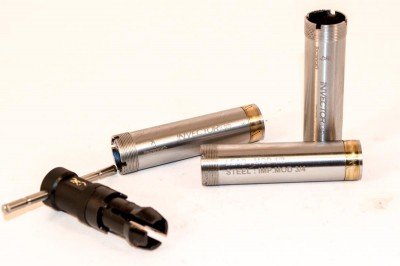
The Browning Citori 725 Feather includes three Invector DS choke tubes: Modified, Improved Cylinder and Full, along with an Invector DS choke wrench.
This Browning Citori 725 came with three Invector DS choke tubes. Let’s talk about the Invector DS system for a bit, as it’s a little different. The “DS” stands for double seal. Each of the 3 ⅛-inch-long tubes has a brass alloy ring around the bottom of the choke tube. The idea behind the ring is to provide a better seal between the choke tube and barrel interior, preventing hot gas and residue from blasting its way in between the two. You know how choke tubes get stuck after lots of shells? One of the design goals of the Invector DS system is to prevent that. I did notice that after shooting, while the interior walls of the choke tubes were crudded up with the usual wad and powder residue, the exterior surface of the tubes were squeaky clean. Apparently the brass alloy sealing ring did its job.
One other thing to note about the Invector DS choke tubes is that they aren’t defined by interior diameter. Browning creates various chokes like Full, Modified and Improved Cylinder by pattern results, not tube dimensions. For example, an Improved Modified choke is supposed to deliver 55-60% of pellets inside a 30-inch circle from a range of 40 yards. Browning tweaks the choke tube design until that pattern is consistently delivered, then calls it an Improved Modified.
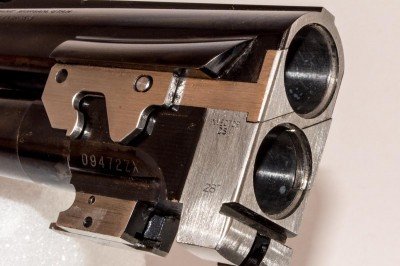
Chambers will accept three-inch shells and feature extended forcing cones to smooth the shot pellet transition from shell to barrel.
As shipped from the factory, the top barrel had the modified ½-choke for lead, while the bottom barrel had the improved cylinder ¼-choke for lead. A full (lead) choke tube was included in the box.
Forcing Cone and Back-bored Barrel
The Citori 725 Feather features the Vector Pro forcing cone. In plain English, this means that the constriction of the forcing cone area is much less aggressive and longer. This gives the pellets a gentler and more polite path from the shell into the normal dimension of the barrel. As a result, pellets suffer less smashing around and tend to remain in their original shape. As a result of that, patterns are more uniform as pellets fly the way they were designed to.
The back-boring process sounds complicated, but really boils down to enlarging the interior diameter of the barrel to the optimum size. Most Browning shotguns back-bore their barrels to .742 inches in diameter. The idea is that this is open enough to reduce friction on the shot wad and column, thereby reducing recoil and potential pellet deformation in the transition through the forcing cone to the barrel. According to Browning, diameters larger than .742 inches can result in gas blowing by the shot wad, resulting in lost velocity potential.
Got Patterns?
All of these features have a couple of benefits. First, recoil is more manageable as there is less friction in the overall process of moving the shot column from the shell to somewhere downrange. This is nice, but the real observable benefit is the quality and consistency of shot patterns.
Depending on what you’re intending to hunt, this gun would most likely burn through #6, #7½ and/or #8 shot. I had tons of #8 on hand, so I did a few patterns tests with the three included Invector DS Choke tubes. I had 25 yards of space, so I connected with my artistic side and traced the obligatory 30-inch circles on some scrap cardboard. As I was most interested in the quality of the pattern and relative difference between the choke tubes, I wasn’t overly concerned with patterning at 25 yards instead of the traditional 40.
For all pattern tests, I fired Remington Sport Loads. These are 2¾-inch shells with 1⅛ ounces of #8 shot, so the safe estimate is that each shell started with about 462 pellets.
Improved Cylinder ¼ Choke: 325 pellets, 70.3%
Modified ½ Choke: 389 pellets, 84.2%
Full Choke: 420 pellets, 90.9%
As you can see by the photos, the patterns were even and centered. Point of aim was the dark dot in the center of each-30 inch circle.
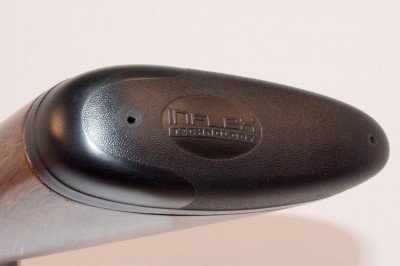
The Inflex recoil pad is soft, yet rounded and slick to prevent it from getting stuck on clothing during the mount.
Recoil in a Featherweight 12-Gauge
Given the ultralight feel of this shotgun, I was ready to be “thumped real good.” However, felt recoil was surprisingly light. The Inflex II recoil pad did its job, and shooting this gun was not at all unpleasant. The Inflex II recoil pad has three primary features. It’s soft and squishy to soften the impact on the shoulder. It’s also smooth and slick, so it doesn’t get stuck on your clothes. Last, it’s got an internal design that directs recoil downward. The idea of directing recoil down is to minimize the shock to your face where it’s welded to the comb. I could tell the difference, and I did not detect that this system pulled the stock away from my face, which could be problematic.
For a completely subjective “feel” comparison, I brought two other Brownings to the range so I could compare felt recoil side by side.
First up was a Browning Gold Fusion with a 26-inch barrel. Since it is a semi-auto, I expected the recoil impulse to feel smoother. The Gold Fusion weighs just about 6½ pounds, so it’s even lighter than the double barrel Feather.
I also did a comparison with my 7¾ pound Browning BPS pump action with its 28-inch barrel. Like the Citori, all recoil is going to come straight back at you. None of it will be soaked up by fancy gas redirection and semi-automatic operation.
Here’s what these not-so-fancy scientific, yet entirely subjective comparisons yielded.
I could tell no difference in felt recoil between the Browning Citori 725 Feather and the Browning BPS pump, even though the pump is a full pound heavier. That in itself is an interesting comparison, as the pump is, of course, a single-barrel, yet Browning managed to shave a full pound with a double-barrel gun. Anyway, the rearward recoil impulse and feel on my jawbone were virtually identical—a credit to the recoil reduction features of the Feather.
The Browning Gold Fusion semi is almost the same weight as the Feather, a little over 6½ pounds by my scale. More important, semi-automatic operation does quite a bit to reduce the felt part of the recoil impulse. If I had to make a choice, I would say the semi was ever so slightly softer in terms of recoil—again a nod to the comfort of shooting the Feather.
Handling
The Browning Citori 725 Feather was designed for ease of carry for upland hunts and other field activities. If you haven’t clued in on my comments yet, it’s incredibly light. The balance point, using my un-scientific balance-on-the-finger test (unloaded) is on the forearm wood, maybe ½ inch in front of the receiver. This places the balance point exactly at the midpoint between the natural position of my hands.
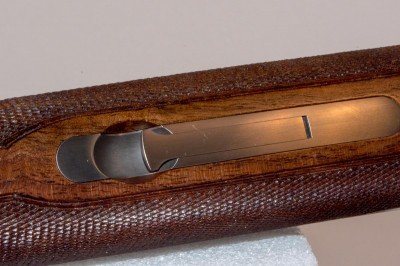
The forearm latch is a representative example of the good wood-to-metal fitting on the Citori 725 Feather.
Mounting the shotgun is a dream. The light weight allows it to move effortlessly into position. The rounded shape of the recoil pad and smooth texture prevent it from getting hung up on clothing during the mount. For me, fit was perfect out of the box. For some reason, Brownings seem to fit my shoulder neck and face dimensions. Mounting the gun with eyes closed, it repeatedly ended up at the perfect elevation with my eye looking right down the rib—not too high, not too low.
Swing is nice. It’s a light gun, so don’t count on momentum resulting from gun weight to prevent you from stopping the barrels when you get all excited about pulling the trigger. The balance helped me with this. If you’re a hunter and want to dabble in clay target sports, there is no reason you can’t use this on the skeet, trap or sporting clays fields. Of course, like any sport where optimized equipment rules, when you get serious about it, you’ll want an optimized gun for the disciplines you choose.
Closing Thoughts
Browning makes a fine shotgun. The featherweight is the standout feature on this model, but Browning has put a lot of attention into supporting features that make it comfortable to shoot. While I can’t detect performance of individual recoil reduction features like the long forcing cone, back-bored barrel and recoil-deflecting butt pad, the sum total makes an observable difference. Check one out; it’s a beautiful gun.
[one_half]
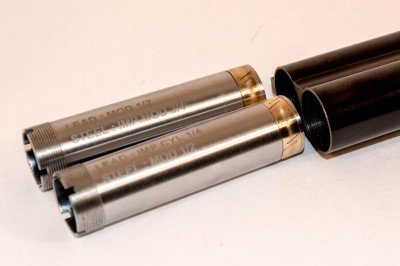
Note the long choke tubes with brass allow sealing rings to prevent gas and residue from getting between the tubes and barrel.
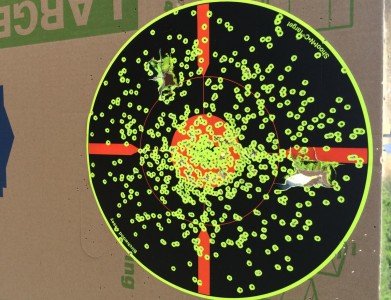
I wanted to see how synchronized the upper and lower barrels were, so I fired two shots to the same point of aim using the same choke. The patterns were right on top of each other.
[/one_half]
[one_half_last]
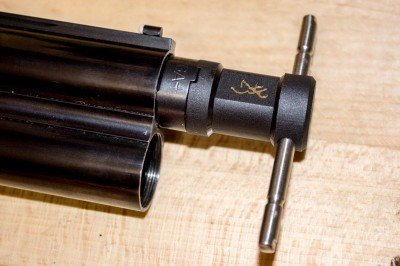
The factory-included Invector DS chokes are flush with the ends of the barrel. If you want longer chokes, optional extended versions are available from Browning.

For initial lubrication I used Italian Gun Grease Protectant and Lubricant all over and Slipstream grease on the hinge.
[/one_half_last]

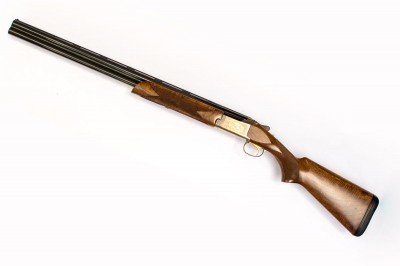
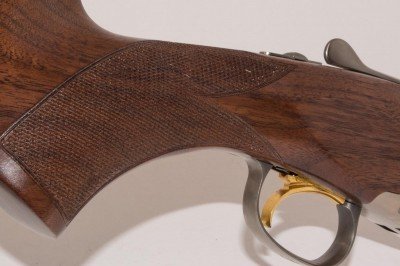
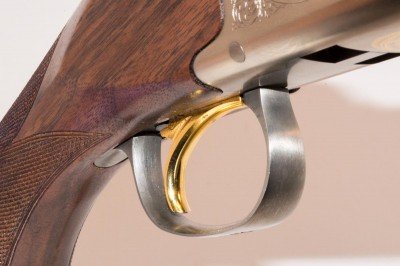
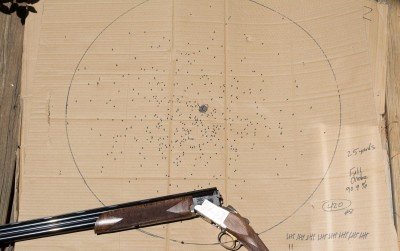
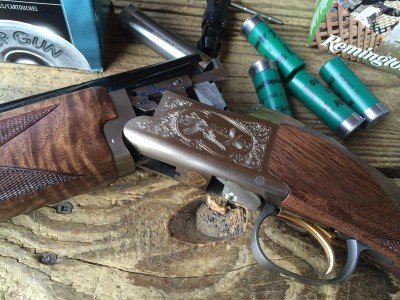
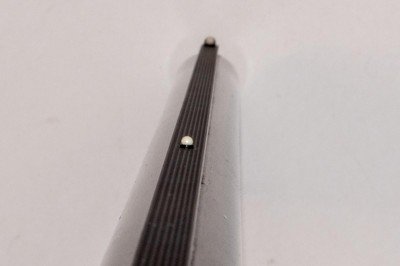
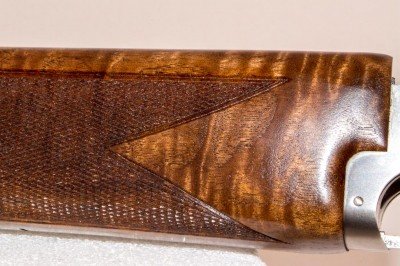
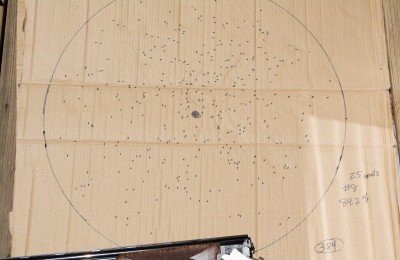
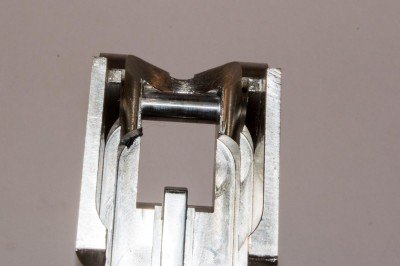
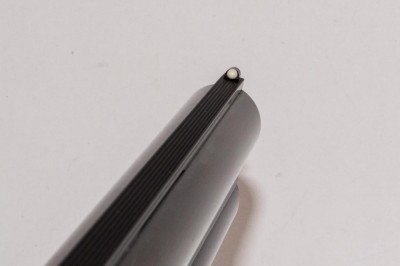

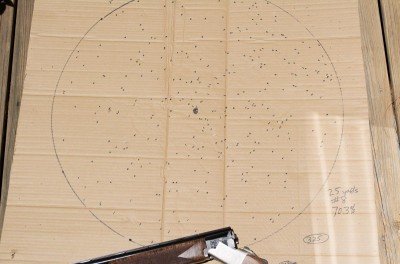
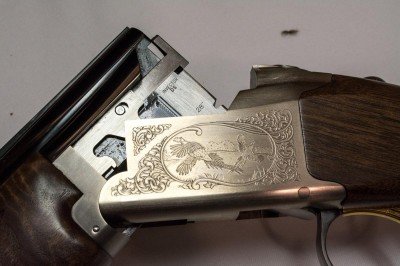
I bought my Feather 12 gauge over under shotgun with a 26 inch barrel weighing just 6 pounds and 7 ounces. I love it and will use it for all my shotgun hunts and for shooting clays to get practice in. I use Extended Invector DS chokes with a improved modified steel light modified lead version in my lower barrel and a extra full steel light full lead choke model in my upper barrel. My all around Shotgun for the rest of my life and pass on to my son. Flushing pheasants on one side and rising ducks on the other. A real beauty.
Try as Browning may they will never make a better gun in Japan than the Belgium superposed super light. I just bought one for 1000.00 and it was money well spent.
I have a beautiful 12 gauge over and under white lightning that weighs 8.2 pounds I’m considering buying the new 725 feather which weighs under 7 pounds i’ll probably be using the gun for Clay and skeet and some hunting am I crazy and thinking of getting rid of my white lightning for a lighter gun ? I guess I already know that I am crazy my question is will the light weight gun hold up to a shooting clays and skeet ? I probably won’t even fire at 300 times a year ?
Is the 725 father to light weight of a gun to be shooting clays and skeet occasionally . I’m concerned the light weight receiver will wear out too quickly ? I’ll probably be shooting clays and ski more often then walking through a field but I do like the light weight feeling of the gun
I’ve had nothing but trouble with this gun!
Purchased October 2015
Gun would not close (lock) Friday Nov 6 & occasionally misfired.
Shipped to Browning Monday Nov 9.
Received gun Dec 14 from Browning.
Dec 26 & 27 misfired on hunts
Feb 10 misfired numerous times from both barrels; on one occasion pulled misfired amo, reloaded different amo, fired, reloaded original misfired amo, fired from both barrels.
Feb 12 misfired on snow goose hunt
Has anyone had trouble with the725 feather locking or misfiring on extremely cold days? I had nothing but trouble with my 625 and went back to my old Citori Lighting
Experiencing it today! Won’t fire…it’s like it’s still on safety even when switched to fire. Great firearm above 40°. For the money you spend on this firearm, you’d expect it to work every time. Incredibly disappointed.
Had the same issue on a pheasant hunt in N Dakota last Dec. It was around 15 degrees and blowing snow. We only kept the dogs out for a couple of hours due to the cold. It warmed up around noon and the gun fired ok.
He is talking about the barrel selector not the top lever to open the action. Some O/U shotguns you move the safety lever to one side or the other to select which barrel you fire first leaving the lever off center. The Browning 725 has a small lever on the safety lever ( switch ) which moves but leaves the safety in the center. Hope this frees up any confusion about what he is talking about
“The selector lever is perfectly centered, something many shotguns don’t seem to care about. For no good reason, an off center selector lever drives me nuts.”
I don’t quite understand what you’re saying with this, and with the photo. O/U guns have a break-in period where the lever moves to the left, and it’s a good guideline to see how much a gun has been shot. I would be very wary of a break-action gun whose lever was centered (with barrels on; they are all centered with the barrels off in my experience) out of the box. I would love to see two photos: one with the barrels on and gun closed looking at the lever, and one with the barrels off looking at the lever.
I’m also one of those guys who wants the light switch screws all lined up too 🙂
It’s really sad to read his comment: obviously he’s one of these typical gun-writers that knows how to shoot or use a shotgun, yet he obviously has no clue nor real ‘in-depth’ technical knowledge of the actual interior design features and how it all works? How any U/O or even Side/Side shotguns is positioning it’s lever naturally in this position, depending on the amount of wear/tear that the gun was exposed to! Any gunsmith/gun-maker ‘worth his salt’ for the likes of myself, could have told him that a lever positioned over the ‘half-line’ (over to the left) is a clear indication of too much wear/tear and that this particular shotgun is well past it’s due date to change the (usually tapered) hinge-pin/ears, before more damage will occur! In fact: it should have been changed while it was right on the ctr. half-line: any amount over this position and it will already cause damage to the rest of the receiver/brl-hook/bites!
Jan
While you may be correct Jan, your need to be an azz about the comment really shows your trolling tendencies.